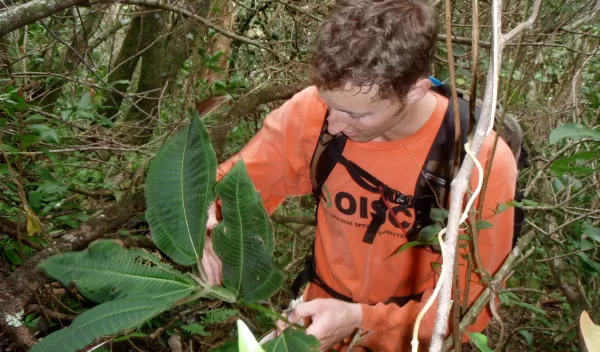
Saving Hawaii From Alien Plants
On the island of O'ahu, Hawaii, cutting-edge research on non-native plants involves a flashing traffic light, magnetic signage and pretzels. A plethora of pretzels.
The flashing yellow light affixes to the top of a slow-moving, white pickup truck that the signage identifies as a botanical survey vehicle. Inside, scientists from the O'ahu Early Detection (OED) Project identify and record the global positioning system (GPS) coordinates of over 100 weed species, slowly mapping their distributions across the entire island. Sustained by the salty pretzel sticks, these scientists are providing information that may help slow the spread of non-native plant species in Hawaii, where the number of non-native plant species is roughly equal to the number of native species.
A National Science Foundation (NSF) Integrative Graduate Education and Research Traineeship (IGERT) program internship allowed me to work with the OED, which is a joint initiative of the Bishop Museum and the O'ahu Invasive Species Committee. The team, consisting of botanists Danielle Frohlich and Alex Lau, is representative of a transition in Hawaii from reactive to proactive management of invasive species: rather than managing widespread populations of established invasives, the OED is using scientific assessments and field surveys to predict which incipient weed species might become invasive in the future.
Migratory plants
Much of my internship focused on analyzing Hawaii's environmental policies pertaining to non-native plant species. Most of the regulations regarding the importation of plant material date back to the 1970s and are designed to limit the impact of non-native species on agriculture. As such, prohibited species are usually those that have been previously associated with agricultural pests or those that have the potential to alter agricultural lands.
Unlike New Zealand, where species are prohibited unless accompanied by a permit or otherwise designated as unrestricted, plants entering Hawaii are generally permitted unless specifically prohibited by import regulations or by the Noxious Weed List. This list includes 75 plant species that, due to their potential to harm Hawaii's industries and ecosystems, are restricted from importation, transportation and sale within the state. The list is somewhat controversial, however, in that it has not been updated since it was created in 1992.
In contrast, the OED recently created a list of over 100 weed species, mostly present in small numbers, using a combination of expert advice, field observations and numeric scores from a weed risk assessment. The assessments are a relatively new technique that allows us to score plants based on their historical associations with invasions and to provide an estimate of a plant's potential to be invasive.
Researchers at the University of Hawaii and the U.S. Department of Agriculture's (USDA) Forest Service developed a weed risk assessment specific to Hawaii and other areas of the Pacific that correctly identifies 95 percent of major pests currently in Hawaii. By identifying newly arrived, non-native plant species and using the Hawaii/Pacific assessment to numerically determine their invasive potential, the OED has generated a list of species that could be the next generation of widespread invasive plants. In mapping their distribution across O'ahu, the OED can provide information to invasive plant management groups and relevant government offices, helping to control these species before they become a problem.
'Detection community' created
In addition to analyzing environmental policy, my internship allowed me to participate in some of the plant surveys conducted by the OED and to interact with the public. I was able to help create a network of botanical experts and enthusiasts known as the Detection Community, which fosters dialogue among OED scientists, researchers, government officials and concerned citizens.
Fieldwork with the OED took me from the botanical survey truck to a helicopter used to airlift botanists to remote mountain peaks to manually remove species like Florida prickly blackberry. I was able to interact with members of the public through presentations and festivals and even had the opportunity to help a Bishop Museum botanist formally describe a new plant species.
Returning to my graduate studies in invasive plant ecology at the University of Rhode Island, I was able to reflect on my internship and the interdisciplinary goals of my fellowship. By following non-native plants into their invaded habitats I was able to gain a broader appreciation of invasive plant ecology across several disciplines including policy, management and community outreach. In my non-native habitat of O'ahu, I gained a greater understanding of non-native plants and how they interact with both the floral and societal counterparts of their host communities.
-- Joshua P. Atwood, University of Rhode Island josh.atwood@gmail.com
This Behind the Scenes article was provided to LiveScience in partnership with the National Science Foundation.
